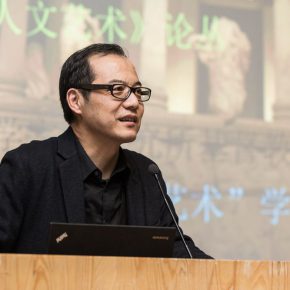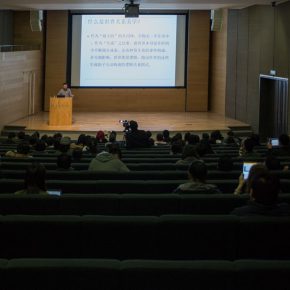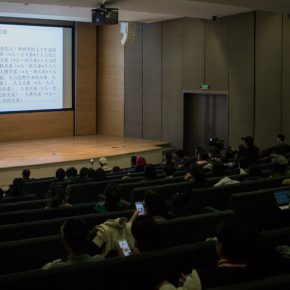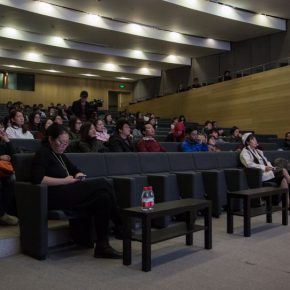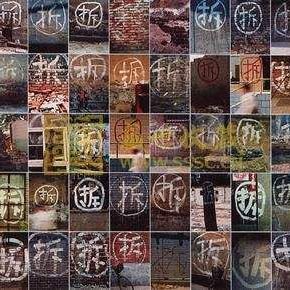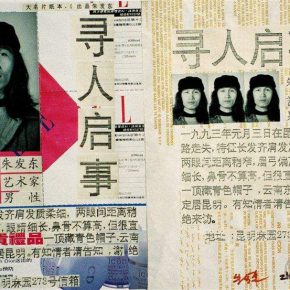
At 7:00 pm on November 21, 2017, the critic Zha Changping gave a lecture entitled: “Avant-Garde Art in the Perspective of Relational Aesthetics” in the Auditorium of CAFA Art Museum. Wang Chunchen, Deputy Director of the CAFA Art Museum presided over the lecture. The lecture regarded the world relational aesthetics as the theoretical foundation, around the issues of what relational aesthetics was, what the world relational aesthetics was, and how to examine the features of the Chinese avant-garde art in the seventh relationship within this framework, to respond to the historical appeal of the cultural pioneer spirit brought in by the globalization era.
“Relational Aesthetics” & “World Relational Aesthetics”The term “Relation Art” was first proposed by Nicolas Bourriaud when analyzing a global art phenomenon that emerged in the 1990s. Nicolas Bourriaud published a book entitled the “Relational Aesthetics” in 1998, trying to theoretically explain the art phenomenon. Zha Changping believed that, Nicolas Bourriaud’s “Relational Aesthetics” mainly regarded contemporary art as a means of interaction and communication among people, while the problem domain was mainly confined to the relationship of all people in the description of the logic of the world-picture.
The term “Logic of the world-picture” is a concept frequently used by Zha Changping, which refers to the schema of logical relations formed by the generative factors of the world. In the picture of world relations where people live, they encounter some basic world factors. In the Christian tradition, the world means the creation made by God, meaning the largest community formed by language, time, individual, nature, society and history. In this largest community, it contains all things; being as a result of “generation”, it refers to the world itself which is continually generated in time and consists of various events that happen and influence each other.
In this relational schema, Zha Changping believes that there are seven relationships: the relationship between man and language, the relationship between man and time, the relationship between man and ego, the relationship between man and nature, the relationship between man and society, the relationship between man and history, and the relationship between man and God. The interaction between these seven relations is then generated into the logic of the world-picture, while the lives of all people is basically communicated with these seven relations. Zha Changping used this “logic of the world-picture” in the criticism of contemporary art, and he found that the avant-garde art actually demonstrated an unique linguistic quality, timeliness, personality, natural sense, social quality, historical and holiness of contemporary people. It results in a true “relational aesthetics of the world”, namely the aesthetics that regards a picture of the world’s relations as the object.
Seven Relationships in the “Logic of the World-Picture”Taking the above discussion on aesthetics as a general theory, Zha Changping then took the avant-garde works of art in China since 1993 as examples, to respectively review Chinese avant-garde art from the perspective of seven relationships.
Zha Changping believed that “the relationship between man and language” was involved in the perspective of people and language of the avant-garde art. For example, the artist Liang Shaoji’s installation art “Fate” (2012-2014), the concept directed at people suffering many mishaps in their life, which is beyond redemption. The silk is snow-white and bright, seeming to be workers who cover the evil and beautify the world, but also quietly remind people of the Wenzhou motor car accident, the frequent mining accidents and oil spills, and other terrible accidents. In addition, Dai Guangyu’s work “Broken Landscape” and Wang Xieda’s abstract sculptures embody the perspective of people and language.
When we face time, we always have a confusion that we live in time but do not know what time is. “The relationship between man and time” involves the perspective of man and time in avant-garde art. Song Dong’s works of performance art are the representative pieces, such as “Writing Diary With Water” (1995), “Printing on Water” (1996), “Breathing” (1996), “Writing Time With Water” (1996), and “Writing Millennium With Water” (1999). In the work of “Writing Millennium With Water,” the artist was dedicated to the perspective of the “nothingness” of time, which actually tells us the process of how the past, the present and the future vanishes from the nothingness.
When people regard themselves as the object of their own consciousness, “the relationship between man and ego” is the relationship between man’s “self” and “me”. “The relationship between man and ego” involves the perspective of man and me. Zhu Fadong’s work of “Notice for Missing a Person” (1993) only contains “a simple definition of the artist’s identity” instead of anything with spiritual or cultural characteristics. The “artist” who was sought in this place was originally an animal-like survivor with only external features such as geography and physiology. Zha Changping called it “an one-dimensional body of life, a being that only regards the continuation of physical life as the content of life.”
“The relationship between man and nature” involves the perspective of character in the avant-garde art. Wu Yiming’s “Xing Dao (Enforcing Justice) Tree” series, “Garden” series, “Chrysanthemum” series and “Three Trees” (2015), started the relationship between man and history, revealing an aesthetic taste of the traditional literati implied in the landscapes and portraits, reminiscent of the life and death of nature.
When it came to “the relationship between man and history”, Zha Changping believed that history as an incident in the past was subjective, and this subjectivity was also extended to the historical statements and historical facts. The subjectivity of historical facts was also reflected in the view of power of the writer who wrote historical facts. In other words, with the power in reality, one can both amend and correct history. However, any history that has been modified inevitably faces the fate of being amended. For example, Zhang Dali’s work “Chinese Historical Picture Archives • Chengzhuang Agricultural Labor School”, if people understand the history of China in the 20th century as only based on the historical pictures provided by the artist, they will get an alternative history (he calls it the writing of the “Second History”).
"The relationship between man and society” involves the perspective of people in avant-garde art. The works involved in the social issues dominated the field of art creation in China. Because, in terms of the nature of the spiritual form of the being, the art is able to help people acutely extend their personal sentiment on life to every corner of social life, which is different from religion and metaphysics, which is also a prophetic force of the presentation of the secret problem. Li Zhayang’s work “Lido” (1998), Wang Jinsong’s conceptual photography “One Hundred Removing Figure” (1999) and Liang Shuo’s “Urban Farmers” (2000) belongs to this category.
“The relationship between man and God” is the last relationship in the logic of the world-picture, and also the ultimate relationship, which involves the perspective of man and God, for example, Chinese artist Ji Zi’s work “Boundlessness of Heaven and Earth” (2009), Zhu Jiuyang’s “Waiting for the Day of Reconciling” (2012). Zha Changping believed that in the contemporary ideological picture, the relationship between the individual and the transcendental person or the ultimate reality within the relationship between man and God should be paid more attention than the others. It is not only because there are only a few works with this perspective, but also because it is always a lack of the true transcendental person with a faith & pursuit in the cultural tradition of Chinese thought.
Text by Yang Zhonghui, translated by Chen Peihua and edited by Sue/CAFA ART INFO
Photo by Hu Sichen/CAFA ART INFO (photos of the works are from the internet)


